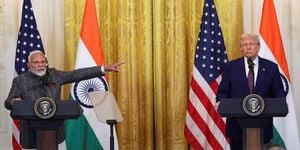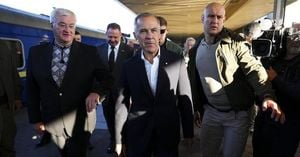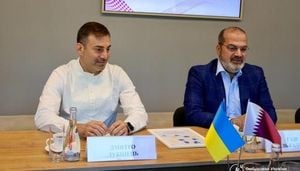In a week marked by high-stakes diplomacy and shifting alliances, the world watched as U.S. President Donald Trump and Russian President Vladimir Putin sat down together at a U.S. military base in Alaska on August 23, 2025. The meeting, scheduled for seven hours but wrapping up in just three, was the first of its kind in a decade—a face-to-face encounter between the leaders of two nuclear superpowers on American soil. The symbolism was hard to ignore: Putin, often depicted in the American media as a war criminal, received a surprisingly warm welcome from Trump, and their body language suggested a rapport that raised more than a few eyebrows in Washington and beyond, according to Espreso TV and several global analysts.
Former U.S. National Security Adviser John Bolton, currently under FBI investigation related to his 2020 book criticizing Trump, offered a blunt assessment in an interview with Espreso TV. "What happened in Alaska, in my view, was that Putin was able to bring Trump back under his influence. That influence, the perceived friendship that Trump likes to emphasize, had been eroded by six months of Trump’s failed attempts to secure a ceasefire. But in Alaska, Putin managed to get it back on track from his perspective." Bolton’s words underscored a growing concern among U.S. and European officials that Russia is regaining leverage in global affairs—at a time when Ukraine’s future hangs in the balance.
Trump’s post-meeting announcement sent shockwaves across NATO capitals. He stated that the U.S. would no longer provide funds or military equipment for Ukraine’s war effort, effectively shifting the burden of support onto European allies. According to a summary by a retired brigadier and analyst, this move was seen as Trump fulfilling his campaign pledge to prioritize diplomacy over military entanglements—even if, as critics point out, his approach to other conflicts like Gaza and Iran remains less consistent. The message was clear: if Europe wants to continue supporting Kyiv, it must do so on its own dime.
The Alaska meeting was not a standalone event. It followed weeks of groundwork, including a trip by Trump’s envoy, Mr. Witkoff, to Moscow, where Putin reportedly agreed to consider a ceasefire—but only on terms that would protect Russia’s core interests. During the Alaska talks, Putin reiterated his view that Ukrainians are historically Russian and that his goal was a stable, safe Ukraine. This position, as reported by multiple sources, placed Moscow in a strong negotiating position even before formal talks began. French President Emmanuel Macron, however, took to social media to express skepticism, tweeting that he did not believe Putin was genuinely interested in peace.
The discussions in Alaska notably sidestepped the thorny issues of territory and land swaps, focusing instead on the more ambiguous topic of security guarantees. German Chancellor Merz later confirmed that territorial questions were simply too difficult to broach, so negotiators opted for the safer ground of discussing security frameworks. Yet, as Bolton pointed out, this vagueness does little to address the underlying conflict: "Putin’s core demand is the capitulation, or thinly disguised capitulation, of Ukraine as a sovereign state. Ukraine, on the other hand, has its own position and its own understanding of what ‘lasting peace’ means."
As the dust settled from the Alaska summit, the Russian Foreign Ministry issued a blunt statement through its spokeswoman: Russia would not accept NATO forces being permanently stationed in Ukraine. This hardline stance drew a sharp line in the sand, making any future security guarantees involving Western troops on Ukrainian soil a near-impossible proposition. Secretary of State Marco Rubio, speaking on August 24, 2025, added another wrinkle by stating the U.S. would not threaten new sanctions against Russia, fearing that such a move could drive Putin away from the negotiating table—and potentially cost Trump the Nobel Peace Prize he is rumored to covet.
Within Ukraine, the mood was tense. President Volodymyr Zelenskyy met with Trump on August 23, 2025, in a meeting that was reportedly more positive than their previous encounter in February. Yet, with Congress in recess until September and Trump’s political base expressing unease about deeper U.S. involvement, Kyiv faced growing uncertainty about its Western support. Bolton warned, "It is legitimate to worry about what Trump will do on any given day during the next three and a half years of his presidency." The risk, he suggested, is that Ukraine could find itself abandoned by Washington, much as past U.S. allies have been in Afghanistan and Vietnam.
Meanwhile, Russia’s position on the battlefield appeared to strengthen. Reports indicated that up to 40% of Ukrainian territory was under Russian control, with the Donbas region—rich in industry and minerals—firmly in Moscow’s grip. The Ukrainian Azov Brigade had surrendered, and Russian forces were now targeting critical infrastructure, including communication hubs and electricity networks. Even with NATO support, Ukraine’s prospects looked increasingly grim. NATO itself faced internal dissent, limited manpower, and disputes over equipment allocations. Without U.S. funding, the alliance’s ability to sustain Kyiv was in doubt—a reality that could threaten NATO’s very cohesion.
Strategically, the Alaska meeting signaled a recalibration of power. Russia emerged with enhanced credibility and influence, having secured recognition that it cannot be sidelined in global diplomacy. The United States, for its part, appeared to be reorienting its priorities, with China looming as its primary long-term rival. Trump’s approach seemed to aim at driving a wedge between Moscow and Beijing, though whether this is achievable remains to be seen. The dollar’s dominance, too, is under threat, as BRICS nations push for de-dollarization and India ramps up rupee-based trade with Russia, Africa, and Latin America.
Putin, for his part, made it clear that his top priority is the lifting of all U.S. and EU sanctions imposed after Russia’s 2022 invasion of Ukraine. He also raised the issue of secondary sanctions affecting India and China over oil purchases, pressing for relief on energy exports. Whether the U.S. and its allies will yield on these points remains uncertain, but the very fact that such discussions are taking place marks a significant shift in the diplomatic landscape.
Looking ahead, the prospect of a trilateral meeting between Trump, Zelenskyy, and Putin—possibly in Moscow—has been floated. Zelenskyy’s tentative agreement to such a meeting reflects Ukraine’s constrained position, as its options dwindle and its fate becomes increasingly subject to external powers. European leaders, too, are coming to terms with the reality that sustaining the war indefinitely is unsustainable, and that NATO, as currently structured, may not survive intact. New alliances and security groupings could emerge, with Russia asserting its indispensability in the evolving order.
For now, the Alaska meeting stands as a watershed moment—a recalibration of global power dynamics, with Russia gaining ground, the U.S. stepping back, and Europe left to grapple with the consequences. As Bolton cautioned, "People should not let their expectations outrun the reality of the parties’ positions." The appearance of diplomatic movement may offer hope, but unless it leads to real breakthroughs on the ground, Ukraine’s struggle is far from over.




